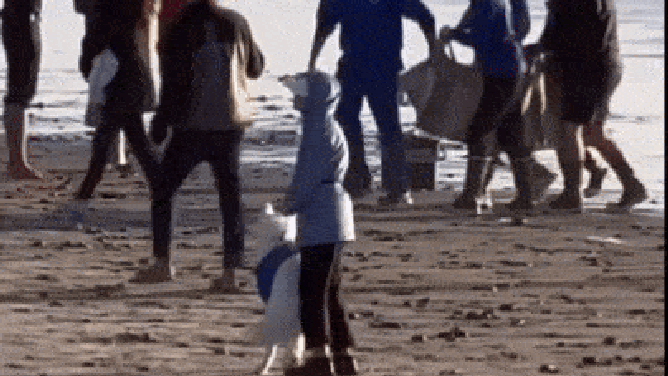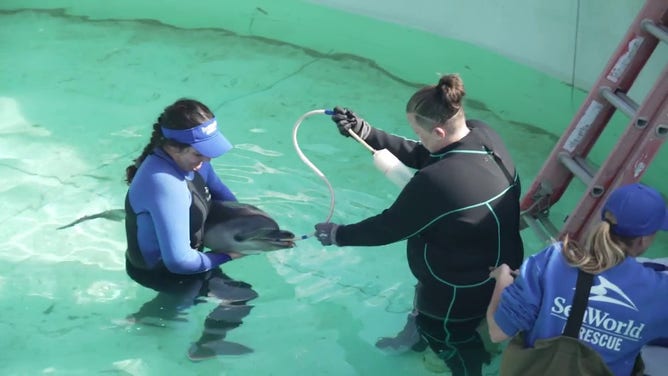Meet Cardiff, the once-in-a-decade dolphin rescue success in California
SeaWorld said the dolphin was found stranded on Cardiff Beach in San Diego County with a beak that was broken in three places.
Watch: Rescued dolphin calf grows stronger at SeaWorld
SeaWorld rescued Cardiff the dolphin calf from a Southern California beach. They didn't give him high odds of surviving, but he beat the odds. Watch as the staff feeds him, helps him swim to get stronger and finally, Cardiff acclimates to a new tank. The rescue was in January on Cardiff State Beach in San Diego County, California.
SAN DIEGO – Rescuers at SeaWorld San Diego are happy and a bit shocked to introduce the world to Cardiff, the first rescued dolphin calf to survive in the past 10 years at the facility.
The rescue team got a call on Jan. 23 that a small dolphin calf stranded himself on Cardiff Beach in San Diego County. Common dolphins only have a 10% survival chance after rescue. So he didn't even get a name, just a number.
"We rescue at least a handful of dolphins and whales every year. And we do everything we can for every single animal. And, when they strand, they're usually in pretty bad shape medically," said Jeni Smith, rescue curator at SeaWorld San Diego. "I guess the forecast is usually pretty grim. Basically, as a rescuer, you try to keep that in mind and, try not to get too attached."
SEAWORLD VETS SAVING MARINE SPECIES ONE ANIMAL AT A TIME

SeaWorld rescuers pulled the stranded dolphin from the water to take to SeaWorld.
(@shalinivadhera / FOX Weather)
Calf should have been nursing
The calf was only 4 to 6 months old with fetal folds and still should have been nursing his mother, who was nowhere to be found. Plus, he broke his rostrum in three areas. That is the beak that holds his jaws. Smith said that Cardiff would have died without rescue.
"It was the entire zoological team that helped us because we had to schedule 24 hours a day, two people a day, to take care of this animal," Smith said. "So, everyone in the park will remember taking care of Cardiff and all of the care and love that went into that animal. It will be something they will remember for their careers."
She said she was not exaggerating when she said everyone in SeaWorld had a hand in saving this mammal. Carpenters worked with vets to set up a makeshift operating room in the quarantine pool because Cardiff's broken rostrum couldn't wait. Seamstresses from the entertainment department crafted a vest with pool noodles to effortlessly float the injured, weakened animal for several days.
VIDEO: WILDLIFE BABY SEASON RESCUES IN FULL SWING AFTER SERIES OF ATMOSPHERIC RIVER STORMS

Seamstresses from the entertainment department developed a "life vest" for Cardiff to use while he got stronger.
(SeaWorld / FOX Weather)
"He was fed every four hours, sometimes every 3 to 4 hours. Because we, of course, tried putting fish in front of his face and seeing if he would eat in that sense," said Smith. "But he was probably a little bit too young to eat whole fish. Just like a baby."
He was tube fed by a two-person team for the first month-and-a-half.
PREGNANT SEA LION CRASHED GOLF TOURNEY, RELUCTANTLY RETURNED TO SEA

For the first month and a half, the staff fed Cardiff seafood formula and vitamins through a tube.
(SeaWorld / FOX Weather)
Cardiff survives milestones
The progress surprised Smith.
"And we knew that we were going to do everything we could, but it's really, ‘Does it survive the first 48 hours?’ It did. And then it's like, ‘OK, well, it survived the first two weeks. Oh my gosh. He met that milestone,’" Smith said. "And then after a month it was like ‘OK, the prognosis is looking better,’ and now here we are, and it is a great success story."
The last rescued dolphin to survive was 10 years earlier. However, that dolphin was older and started eating fish on day three, Smith said. That animal was released back into the wild.
The team worked to rehab Cardiff to release him into the wild too, but his age and injuries made the young mammal too dependent on humans.
WHY DID THE SEA LION CROSS THE ROAD? ANOTHER SEAWORLD RESCUE

Staff monitoring the young Cardiff in a pool.
(SeaWorld / FOX Weather)
Non-releasable
"We were going to, rehabilitate it with the intention of returning if we felt that was the right thing for the animal. And so, when we discussed with the vets and the vets discussed with NOAA, and it was determined that his chances of survival and being returned were very were pretty much slim to none," Smith said. "And the recommendation would be for him to not be returned and to be placed in a zoological institution. Then it's time to give him a name."
The entire park voted to name the youngster Cardiff after the beach where he was rescued. Visitors to SeaWorld can see Cardiff swimming with and learning from his adopted pod. One dolphin with maternal instincts took Cardiff in and treated him like her own calf.

A staff member feeding Cardiff.
(SeaWorld / FOX Weather)
So far this year, SeaWorld has rescued around 200 animals – the majority are sea lions, seals and birds. They have a much higher survival and release rate. The team only gets five to 10 rescue calls a year for dolphins and whales.
Cardiff is currently eating about 8 pounds of food every day and weighs about 66 pounds.
"I'm not exactly sure what his future holds because, myself as the rescuer, I've done my job, and now I've passed the torch to the dolphin area," Smith said. "He is still very, very young and a naive animal. Right now, their main goal is to build a relationship with him."
